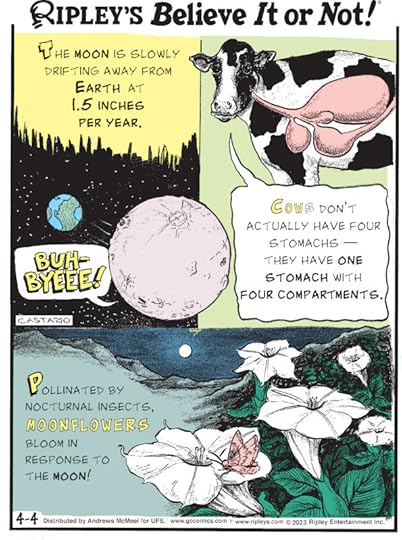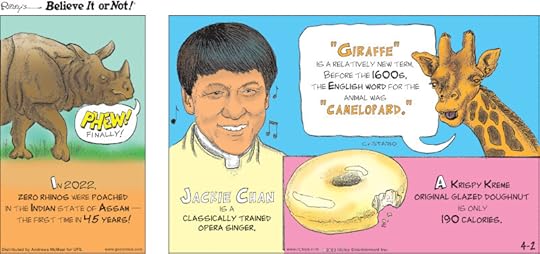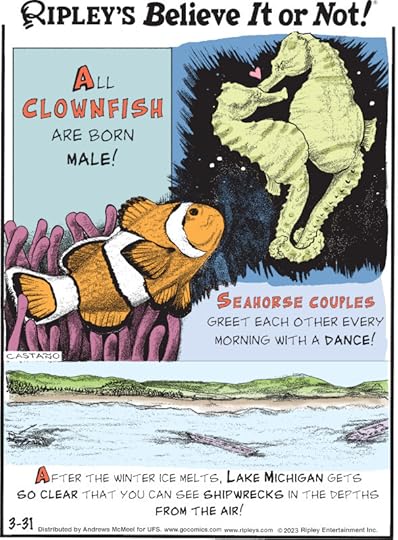Ripley Entertainment Inc.'s Blog, page 34
April 5, 2023
The Real Nacho Libre: The Unbelievable Life Of Fray Tormenta
Featured in Ripley's Believe It or Not!

Over the course of a human lifespan, the average person will work approximately 90,000 hours. (Apparently, punching the time clock sneaks up on you.) As for career change stats, those are surprising, too. While there’s long been a rumor circulating that most workers will change careers seven times, there’s no hard data to prove this.
But we do know the average employee makes a significant job switch around the age of 39.
And roughly 52 percent of Americans mulled the idea of a career change in 2022. Why the switch-up? Some workers get tired and others may feel underappreciated. But most agree higher pay is central to their decision.
When it comes to dramatic career shifts, however, few people compare to Nacho Libre.
From Humble Beginnings to Luchador FameHe’s known by many names. Nacho Libre. Fray Tormenta. Father Benitez. And he’s had Jack Black play him on the big screen in 2006’s eponymous hit Nacho Libre. But for the man, christened Sergio Gutierrez Benitez, who gained fame as a priest and luchador, life proved tough from the start.
Benitez started out in the school of hard knocks as a gang member and drug addict. By the ripe old age of 22, he added alcoholic to the list. This path represented a no man’s land of poor decisions. And Fray Tormenta soon realized he needed a way out. He turned to the Catholic Church, and more specifically the Piarists Order, for answers.
Because of his humble and difficult beginnings, Benitez had a heart for others’ suffering, and he wasn’t afraid to rub elbows with the so-called “dregs of society.” These qualities have made him an especially compassionate and loving priest. Over time, the budding priest found himself surrounded by thieves, gang members and orphans. People in truly desperate straits.
The Priest Turned LuchadorNot one to take other peoples’ suffering in stride, Benitez began adopting orphans. They moved with him from location to location as he got transferred by the church. Benitez knew how desperately these orphans needed a stable home, but he didn’t know where to get the funding to make this dream a reality.
The real person Jack Black’s Nacho Libre character was based on: Fray Tormenta pic.twitter.com/iHp0IswdiN
— Pro Wrestling Stories (@pws_official) September 3, 2022
Eventually, he located an orphanage site in Texcoco but got thwarted again. The local diocese refused to fund the orphanage. So, Benitez had to think outside of the box. And he did in a way that people continue to talk about today. He became a professional wrestler or luchador known as Fray Tormenta. In the ring, he fought bravely and knew how to entertain. He also proved especially generous. Living in abject poverty, despite his growing fame, the luchador donated all of his earnings to support the orphanage.
The Luchador Turned PriestNevertheless, Nacho Libre drew the ire of local church officials and soon a compromise had to be reached. Benitez agreed to end his fighting days as long as the diocese supported his orphanage. As his renown grew, Hollywood got interested. All told, Fray Tormenta sold the rights to his life to two different filmmakers. The first film debuted in 1991 as The Man in the Golden Mask and was followed by Jack Black’s previously mentioned triumph.
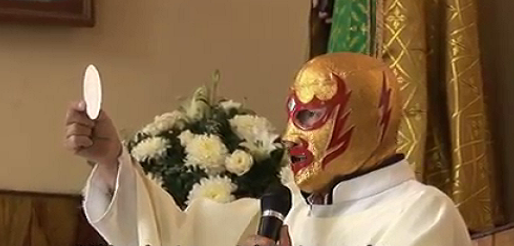
Credit: Human Via Wikimedia Commons (CC BY-SA 3.0).
Both films earned plenty of attention, and a fascinating thing happened to Fray Tormenta after so many years of shepherding by day and fighting by night. Benitez’s real-life character merged with the golden-masked luchador, and he even started giving communion with the wrestling mask on! No challenge has proven too tough for Nacho Libre in his support of orphans, and his commendable work continues today.
By Engrid Barnett, contributor for Ripleys.com
EXPLORE THE ODD IN PERSON! Discover hundreds of strange and unusual artifacts and get hands-on with unbelievable interactives when you visit a Ripley’s Odditorium!Source: The Real Nacho Libre: The Unbelievable Life Of Fray Tormenta
CARTOON 04-05-2023
April 4, 2023
Humans May Soon Live Twice As Long
Featured in Ripley's Believe It or Not!

St. Augustine, Florida, hosts the “Fountain of Youth,” but it has proven pretty stingy on doling out enteral life over the years. The idea of a living spring of water permitting people to cheat death originated with the Taino Indians. They believed the life-extending aquifer existed on the island of Bimini (in the Bahamas) and in a river situated in present-day Florida. Once the Spaniard Juan Ponce de Leon arrived on the scene in the 16th century, he became enthralled by the notion, launching a famed quest for immortality.
Considering Ponce de Leon has been dead since 1521, we can surmise the pursuit of “life eternal” (shoutout to Dracula) didn’t go as planned. But that hasn’t stopped many other humans from sharing in his dream. Now a group of scientists thinks we may be closer to breaking the longevity glass ceiling than ever before. And if one 89-year-old Japanese man has his way, above that glass is plenty of surfing.
Here’s everything you need to know about why humans may someday live twice as long as they do today and why you should consider spending those extra years hanging ten.
The Study That Challenges How We Think About AgingIn a letter to Jean-Baptiste Leroy, a prominent French scientist, Benjamin Franklin astutely noted, “The only two certainties in life are death and taxes.” Mark Twain would promote this witty phrase into popular parlance, hitting on a truth that’s hard to deny. (Especially come mid-April!)
While there’s no way to escape death, a group of scientists believe it could be postponed. At least, that’s what their latest paper argues. (Sadly, taxes remain just as certain.) How did these researchers come to their surprising conclusion? By analyzing life and death records from 19 nations between the 18th and 19th centuries. (They made 1969 their end date.) In the process, they discovered that the mortality rates of people born after 1910 indicate there’s potential to live longer. Maybe a lot longer.
David McCarthy of the University of Georgia explains, “In most of the countries we examined, we project that the maximum age will rise dramatically in the future. This will lead to longevity records being broken in the next 40 years or so.” Not everyone agrees with this assessment, and they point to flaws in the study. These include the glaring fact that the study doesn’t account for the biology of aging. Nevertheless, it’s an optimistic message that most people can get behind. After all, who doesn’t want to believe that age is just a number?
The 89-Year-Old Surfer Who Won’t Let Age Stop HimWhile the study above has surprised many people in the scientific community and the general public, Seiichi Sano of Fujisawa, Japan, isn’t among them. The 89-year-old surfer has long understood that age is a mindset, and he’s not about to give up taking life by the horns, even after nine decades. Instead of falling into the mold and behaving the way people think men his age should act, Sano has spent his advanced age adventuring.
At 89-years-old, Seiichi Sano has been recognized by Guinness World Records as the “oldest person to surf (male)” and he doesn’t look to be slowing down anytime soon. https://t.co/j5KzyG68iq pic.twitter.com/TcCbK79hKv
— AP Sports (@AP_Sports) March 31, 2023
Whether that means climbing Japan’s tallest peak, Mount Fuji, at 80 years old or catching gnarly waves while nearly in his 90s. He plans on surfing until he’s 100 and is even toying with the idea of taking up bouldering. That said, he’s no mere advanced-age adrenaline junkie. In fact, he thinks bungee jumping sounds “too scary.” So, what’s the secret to his incredible longevity and boundless energy? Mind over matter.
He notes, “I don’t consider myself an old man. I have never thought of myself as an old person. I always feel that I can still move forward. I can still do it. I can still enjoy it.” Does that mean Ponce de Leon should have been looking for a positive attitude rather than a mythical fountain? Perhaps. But one thing’s for sure, Sano is our man when it comes to #AgingGoals.
By Engrid Barnett, contributor for Ripleys.com
EXPLORE THE ODD IN PERSON! Discover hundreds of strange and unusual artifacts and get hands-on with unbelievable interactives when you visit a Ripley’s Odditorium!CARTOON 04-04-2023
April 3, 2023
CARTOON 04-03-2023
April 2, 2023
CARTOON 04-02-2023
April 1, 2023
CARTOON 04-01-2023
March 31, 2023
Joseph Pujol And The Fart Worth $100,000
Featured in Ripley's Believe It or Not!
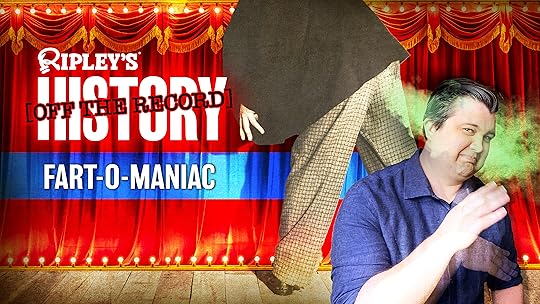
Let’s address the title immediately, shall we? How could a fart be worth $100,000? Well, here on Ripley’s History Off the Record, we run the VPN and throw our browsers incognito so you don’t have to, and today we’re talking about the greatest flatulist of all time: Joseph Pujol, better known as Le Petomane—a French performer whose stage name loosely translates to the Fartomaniac.
How It All BeganNow, immediate disclaimer here, my French pronunciation is absolutely abysmal, so apologies in advance. Joseph Pujol was born in Marseilles, France in 1857. As a boy, he had a strange experience in the sea that would eventually lead him to become a professional farter, performing for royalty. After leaving school one day, he went for a swim, as he dove underwater holding his breath, he felt the icy waters enter his rear.
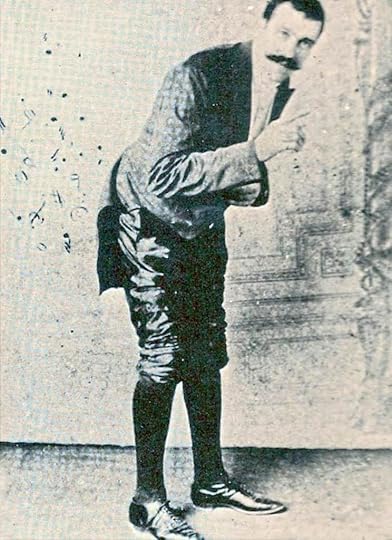
via Wikimedia Commons.
This is when he realized he had preternatural control of his abdominal muscles. He could inhale with his anus, and even slurp up water, then control the release with his sphincter muscles. As an adult, Pujol could eject a stream of water from his anus stretching 16 feet. He—and this is a quote—was able to “wash your walls with a bucket and a squat.” A feat he apparently proved to his fellow soldiers while serving in the army, who described his ability as a “veritable fart fantasia.”
Pujol eventually became a baker and delighted customers with his controlled flatulence. It’s during this time he honed his musical skills, imitating orchestras and telling customers there was a full band behind his bread counter.
Taking His Skills To The StageEventually, Pujol decided to take his fartistry to the stage. At first, audiences weren’t sure what to think. Historian Alison Moore writes in “The Spectacular Anus of Joseph Pujol” that the very hilarity of a man making money with his ass was both the strength of his act, but also very possibly what held him back. Pujol himself didn’t naturally have the appearance of a star, and when booking gigs was said to burst into managers’ offices declare he could control the elasticity of his anus at will, and then before anything else could be said, bend over and start flatulating musically until they gave him the job.
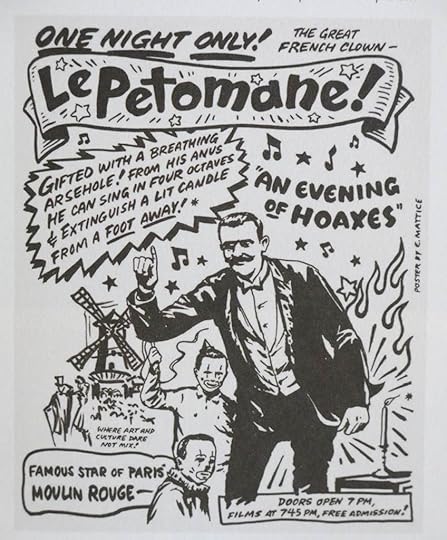
via Wikimedia Commons.
Audiences would eventually find his antics to be a gas. By 1892, Pujol high society became so enamored with the Fartomaniac, that he performed at the Moulin Rouge. In Paris, his act was much more than small musical notes. No, at the moulin Rouge his farts became cannon fire and thunderstorms, blowing out candles from many feet away, smoke from his rear, and he even showcased his ability to play the ocarina using tubes tied to his anus.
Audiences included King Edward VII, Leopold II, and even Sigmund Freud. Several accounts say people would laugh so hard during his performances that they would pass out.
A Star Was BornPujol turned his crass act into a life of elegance and sophistication, eventually outgrowing the Moulin Rouge, and taking his own hand at show writing and production, but this is where his rogue flatulence would cost him. After performing for a friend on hard times, the Moulin Rouge sued Pujol for flatulating out of contract. Eventually, the matter would be settled for 3,000 Francs, the equivalent of $100,000 today. Unfortunately, this would also prove the end of Le Petomane’s career, war had reared its head in Europe, and Pujol would return home to open a biscuit factory.
Believe It or Not!, a Parisian medical school tried to buy the late Fartomaniac’s body, hoping to learn the secrets of his rectum, after his death in 1945, but the family cheerlessly responded that “some things in life must simply be treated with reverence.”
That’s it for today, let me know in the comments if you’d go to a show starring Le Petomane. Stay tuned for the next History Off the Record.
EXPLORE THE ODD IN PERSON! Discover hundreds of strange and unusual artifacts and get hands-on with unbelievable interactives when you visit a Ripley’s Odditorium!Engineers Create 3D Printed Cheesecake Made Of Edible Ink
Featured in Ripley's Believe It or Not!
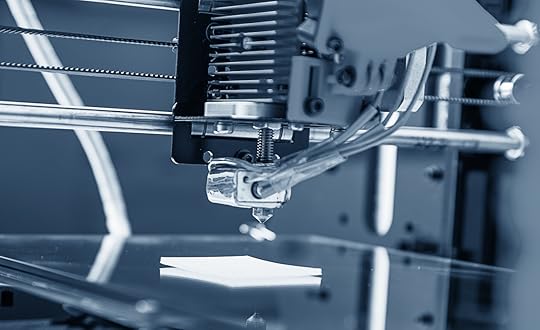
A group of mechanical engineers from Columbia University have 3D printed an edible, albeit slightly odd-looking, cheesecake, and it may not be too long before these types of printers become common in home and industrial cooking spaces, according to the university’s School of Engineering. The team behind the desert believes 3D printing multi-layered food may improve food safety, promote customizable meals, and let people choose nutritional content.
Tasty TartThe 3D cheesecake was made of edible food inks. The team created a slice consisting of banana puree, strawberry jam, cherry drizzle, peanut butter, graham cracker, and frosting. The desert features graham cracker as the foundational element for each layer of the cheesecake. Supporting, pool-like layers consist of peanut butter and Nutella, which hold the softer ingredients (banana and jam) in place.
The cheesecake features multi-tiered structures like what you would see in an architectural space. The key in its construction was to include additional structural elements to support softer substrates for multiple ingredients.
It took about 30 minutes to cook one slice of cheesecake, according to CNN. But more importantly, what does it taste like? It has been compared to Willy Wonka’s three-course dinner chewing gum, which Violet Beauregarde tried in the famous film “Charlie and the Chocolate Factory.” Different waves of flavor from the cheesecake hit the palate at different times.
Computer Chefs?3D printers for cooking have the potential to do the jobs of ovens, stovetops, and microwaves, eliminating the need for these appliances. The question is: will people be open to using them? They could potentially allow users to dial in the exact micro and macro-nutrients they want in a meal, which could promote healthy eating habits.
The team of researchers behind the 3D cheesecake worked in Columbia Professor Hod Lipson’s Creative Machine’s Lab to determine the pros and cons of this type of technology, how 3D-printed food compares to the type of food people eat today, and how it will affect modern kitchens.
Lipson’s lab has been experimenting with food technology since 2005. However, up until this point the food was uncooked and not particularly appetizing. Study lead author, postdoctoral fellow in the lab, and 3D cheesecake chef Jonathan Blutinger opted to create a dish with seven ingredients, that were cooked with a laser.
Blutinger noted that successful 3D printed food technology would need to be assisted by industries such as food cartridge manufacturers. There would also need to be a space to develop and share recipes. “Its customizability makes it particularly practical for the plant-based meat market, where texture and flavor need to be carefully formulated to mimic real meats,” he explained.
The Printable Benefits3D printing involves making processed foods, which is typically low in nutrients. But there are potential benefits, according to Pace University Nutrition and Dietetics professor Christen Cooper. It will give some people more personalized nutrition. In addition, it could potentially help those with swallowing disorders by “mimicking the shapes of real foods with the pureed texture foods that these patients—millions in the U.S. alone—require.”
This is what happens when food science and 3D printing collide pic.twitter.com/RN4Vrulbem
— Mashable (@mashable) January 5, 2020
Another benefit of 3D foods and laser printing is it could give chefs the ability to use local flavors and textures more precisely. It could also provide convenience for a variety of different people: athletes, nursing home dieticians, and those with food restrictions, for example. In addition, in wake of the COVID-19 pandemic, less human handling of food could lessen the likelihood of foodborne illness and disease transmission. 3D cooking uses high-energy targeted light for heating, potentially making it more cost-effective and sustainable than other options.
Still, more research is required. Since food needs to be “assembled” in different ways, different meals would require “novel ingredient compositions and structures,” according to Lipson.
By Noelle Talmon, contributor for Ripleys.com
EXPLORE THE ODD IN PERSON! Discover hundreds of strange and unusual artifacts and get hands-on with unbelievable interactives when you visit a Ripley’s Odditorium!Source: Engineers Create 3D Printed Cheesecake Made Of Edible Ink
CARTOON 03-31-2023
Ripley Entertainment Inc.'s Blog
- Ripley Entertainment Inc.'s profile
- 52 followers



